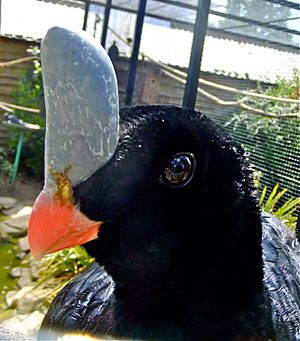Horned curassow facts for kids
Quick facts for kids Horned curassow |
|
|---|---|
 |
|
| Conservation status | |
| Scientific classification | |
| Genus: |
Pauxi
|
| Species: |
unicornis
|
|
|
 |
|
| Synonyms | |
|
|
The horned curassow (Pauxi unicornis) is a cool bird found in the warm, wet forests of South America. It's also called the southern helmeted curassow. This bird is part of the Cracidae family, which includes other curassows, guans, and chachalacas.
Scientists James Bond and Rodolphe Meyer de Schauensee first described this bird in 1939. They found a specimen in Bolivia. Later, in 1971, more horned curassows were found in Peru. These were thought to be a new type, or subspecies.
The horned curassow is a large bird, mostly black, with a special "horn" on its head. It's quite rare and doesn't live in many places. Sadly, its home is shrinking because of habitat loss. Because of this, the International Union for Conservation of Nature says it is "critically endangered". This means it's at a very high risk of disappearing forever.
| Top - 0-9 A B C D E F G H I J K L M N O P Q R S T U V W X Y Z |
How Scientists Classify the Horned Curassow
Scientists group living things into categories. This helps them understand how different animals are related. The horned curassow belongs to a group called Pauxi.
Discovering New Types
In 1937, a person named Mr. M. A. Carriker found two horned curassows in Bolivia. These were the first ones known to science. Later, in 1969, two more were found in Peru. These Peruvian birds looked similar but were found far away.
In 1971, scientists John Weske and John Terborgh described the Peruvian birds as a new subspecies. They named it koepckeae to honor Maria Koepcke, another scientist.
Different Ideas About Grouping
Sometimes, scientists have different ideas about how to group animals. For the horned curassow, there have been many discussions. Some thought the Bolivian and Peruvian birds were just different types of the same species. Others, like Gastañaga and his team in 2011, believed the Peruvian bird (koepckeae) was a completely separate species. They even gave it a new English name: Sira curassow. Local people in Peru call it piuri.
Scientists also discuss if the Pauxi group should be separate or combined with other bird groups like Mitu or Crax. It's like deciding if different types of apples should be in their own basket or all in one big fruit basket! Most scientists today agree that Pauxi, Mitu, and Crax are distinct groups.
What the Horned Curassow Looks Like
The horned curassow is one of the biggest birds in its family. It can grow to be about 85 to 95 cm (33 to 37 in) long. That's almost as tall as a 10-year-old kid!
Size and Weight
Large male horned curassows can weigh up to 3.7 to 3.9 kg (8.2 to 8.6 lb). Only the great curassow is usually heavier. Other curassows, like the black curassow and helmeted curassow, are about the same length.
Special Features
The most unique thing about the horned curassow is the horn on its forehead. This horn can stick out more than 6 cm! Its body feathers are mostly black. However, its belly, thigh feathers, and the feathers under its tail are white. The tips of its tail feathers are also white.
Conservation Status
The horned curassow is in danger because of habitat loss. This means the forests where it lives are being cut down or changed by humans.
Where It Lives
In Bolivia, the horned curassow's home might cover an area of 4,000 km2. This includes important places like Amboró National Park, Carrasco National Park, and Isiboro Sécure National Park. Even with scientists looking for them, they haven't found these birds in all parts of this area.
Why It's Endangered
Because its population is small and getting smaller, the horned curassow's conservation status was changed to "Endangered" in 2005. Now, it's considered "Critically Endangered," which is the highest risk category before extinction. This shows how important it is to protect its forest home.
See also
 In Spanish: Paujil unicornio para niños
In Spanish: Paujil unicornio para niños


